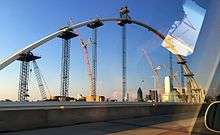Margaret McDermott Bridge
| Margaret McDermott Bridge | |
|---|---|
 North arch, July 2016, with a view of Downtown Dallas | |
| Coordinates | 32°46′13.4″N 96°49′06.6″W / 32.770389°N 96.818500°WCoordinates: 32°46′13.4″N 96°49′06.6″W / 32.770389°N 96.818500°W |
| Carries |
|
| Crosses | Trinity River |
| Locale | Dallas, Texas |
| Owner | TxDOT |
| Characteristics | |
| Design | Cable-stayed bridge with suspended arches |
| Material | Steel, Concrete |
| Height | 340.0 feet (103.6 m)[1] |
| Longest span | 1,125.0 feet (342.9 m)[1] |
| History | |
| Designer | Santiago Calatrava, in part |
| Constructed by | American Bridge Co. |
| Fabrication by | Tampa Steel Erecting Company[2] |
| Construction start | 2012 |
| Construction end | 2017 |
| Construction cost | $100 million+ |
| Opened | 2013 |
| Replaces | Interstate 30 Trinity River Bridge |
| Statistics | |
| Toll | None |
The Margaret McDermott Bridge is a conventional concrete pier-and-beam freeway bridge[3] with cable-stayed bike lines over the Trinity River in Dallas, Texas. It is intended to replace the existing late-1950s to early-1960s Interstate 30 (I-30) bridge, which has reached its end of life.[1] It was partially designed by Santiago Calatrava, and is part of the Trinity River Project and the Horseshoe Project.[1] It was named for Margaret McDermott, an area philanthropist.[2]
History
As part of the Trinity River Project and Horseshoe Project, the Margaret McDermott Bridge was one of three new Santiago Calatrava-designed bridges planned to cross the Trinity River. However, plans for the McDermott Bridge were scaled back, and plans for a third bridge along I-35E were scrapped, due to budget issues. On December 12, 2005, construction of the Margaret Hunt Hill Bridge began, and it opened on March 29, 2012.
The Margaret McDermott Bridge was planned to replace the existing I-30 bridge over the Trinity River. It was originally scheduled to begin construction in 2011 and be completed by 2014. However, in late 2011 funding for the bridge was moved to come from within the Project Pegasus initiative, with construction contracts awarded in mid-2012. The new plan featured "toned-down" elements of its original arch design, although Calatrava was still scheduled to perform the design work.
After delays, construction on the bridge began in 2012, costing over $200 million.[4][5] Specifically, the non-functional arches cost $115 million, while the actual freeway bridge was paid for by the state and cost an additional $120 million[6]. The main concrete part of the bridge, which carries I-30 traffic, opened in 2013. The 1,200-foot-long (370 m) steel suspension arches on both sides of the bridge, which also house the pedestrian and bicycle paths, are separate from the concrete part.[7] In April 2014, footings for the arches were constructed, while steel fabrication took place at Tampa Steel Erecting Company's plant in Florida. The general contractor, American Bridge, expected steel components to arrive on site in Dallas during the fall of 2014. The steel arches were completed in 2017, and the entire bridge was planned to open by the end of the year.
Despite the concrete part of the bridge being open to I-30 traffic, the arched pedestrian and bicycle bridges are still closed, due to concerns with cables that connect the arch to the base of the bridges, and their resistance to heavy winds. When they vibrate from these winds, this has resulted in multiple incidents where the stress from the vibrations caused several cable anchor rods to fail.[8] Furthermore, the stress has also caused the bridges to crack significantly and resulted in multiple occasions in which rods were cracked and twisted, with the small diameter of the rods resulting on putting more stress on them.[9] The lack of testing and the multiple issues plaguing the bridges led to a large dispute; Calatrava blamed the contractor for a lack of testing and using the wrong parts, and state transportation officials blamed Calatrava and the city of Dallas.[10] Due to that, coupled with the need to add additional painting and lighting, there is currently no set date for the arched bridges to open to pedestrian and bicycle traffic.[11]
Architecture
The bridge consists of a conventional concrete pier-and-beam concrete part which is 340 feet (100 m) tall and has a 1,125 feet (343 m) main span. The concrete part carries 10 main lanes of I-30 traffic with one reversible high-occupancy vehicle lane and four frontage road lanes.[1] The decorative steel arches are both 1,200 feet (370 m) feet tall, and house paths for bicycle and pedestrian facilities.[1]
See also


References
- 1 2 3 4 5 6 Margaret McDermott Bridge update Check
|url=value (help). City of Dallas. January 11, 2013. Retrieved August 20, 2014. - 1 2 "Horseshoe Project". Trinity River Corridor Project. Archived from the original on July 18, 2014. Retrieved August 20, 2014.
- ↑ Schutze, Jim (2018-01-30). "Undisclosed Documents Reveal Flaws in Margaret McDermott Bridge, Preventing Opening". Dallas Observer. Retrieved 2018-06-18.
- ↑ Calatrava, Santiago. "Margaret McDermott Bridges (IH30)". Retrieved March 3, 2018.
- ↑ Kalthoff, Ken (January 30, 2018). "Opening Delayed on Margaret McDermott Hike and Bike Bridges". Fort Worth, TX: KXAS-TV. Retrieved March 3, 2018.
- ↑ Schutz, Jim (13 June 2018). "Trinity Trust Foundation Looking for a Construction Manager". Dallas Observer.
- ↑ "Santiago Calatrava's second Dallas bridge faces engineering questions". The Architect's Newspaper. January 30, 2018. Retrieved March 3, 2018.
- ↑ "Flaws in Margaret McDermott Bridge spark dispute among Dallas, state officials, Calatrava". Dallas News. January 30, 2018. Retrieved March 3, 2018.
- ↑ "Undisclosed Documents Reveal Flaws in Margaret McDermott Bridge, Preventing Opening". Dallas Observer. January 30, 2018. Retrieved March 3, 2018.
- ↑ "Top Stories: Officials Feud Over Margaret McDermott Bridge Flaws". Kera News. January 31, 2018. Retrieved March 3, 2018.
- ↑ "Finger pointing after Margaret McDermott bridge flaws revealed". Dallas: KDFW-TV. January 31, 2018. Retrieved March 3, 2018.